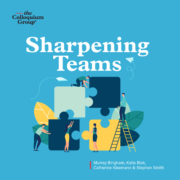Perhaps the number one problem with presentations is that the speaker is focused solely on what they want to say, rather than what their audience needs to hear.
A key element of effective communication is to know your audience. Some presenters think that fifty pages of information and many presentation slides demonstrate thoroughness. However, it usually only deadens the mind of the listeners.
At The Colloquium Group we have found the value of helping teams consider the needs of their audience when preparing reports or presentations. Instead of focusing on what they want to say, they are challenged to present the right kind of message, so the audience gets what they need, in the form they need, to take action. This is not always obvious, for example, when a board asks for information, what they usually want is analysis.
Information represents the facts reported on the available data (e.g., financial, clinical or operational). Analysis goes much further—it attempts to give meaning and implications while testing reasons why this might be happening. It is easy to provide a board with lots of information, but without insightful analysis, it is very difficult for them to make a clear decision.
Through our research with teams, we identified four different approaches while presenting reports. Each with a different balance of information or analysis. As leaders use the most appropriate approach, their presentations become more impactful. When they get it wrong, the message falls flat and frustrates everyone in the room. Either getting bored, bogged in detail or confused saying, ’So what do I do with this?’
A board can make
a decision more astutely
when they are provided
with concise analysis.
Here are the four approaches.
A great presenter will be able to use all four. Based on who their audience is and the purpose what they need.
The sales pitch is most useful when encouraging one direct response.
Often emotional, it synthesises details and possibilities into simple, clear slogans and statements. It favours endorsements over evidence.
The technical report is detailed and complicated.
It is best suited for an audience of technical experts. Decision-makers usually lose patience with the length of these reports and the lack of practical recommendations.
Research findings are rigorous and comprehensive.
An evidence-based approach can include legal memoranda, medical journals, or complex financial modelling. This approach is most effective when the audience has significant expertise.
The executive summary is short, sharp and powerful.
It is most effective for boards, senior management and decision-makers. They want a summary of the issues and clear recommendations for what can be done.
 https://colloquiumgroup.com/wp-content/uploads/2022/11/1181712.jpg
1000
1500
Stephen Smith
https://colloquiumgroup.com/wp-content/uploads/2019/12/the-colloquium-group-logo1-1.svg
Stephen Smith2022-11-17 12:49:212024-02-03 14:09:16Tool: Fostering a trusting team
https://colloquiumgroup.com/wp-content/uploads/2022/11/1181712.jpg
1000
1500
Stephen Smith
https://colloquiumgroup.com/wp-content/uploads/2019/12/the-colloquium-group-logo1-1.svg
Stephen Smith2022-11-17 12:49:212024-02-03 14:09:16Tool: Fostering a trusting team https://colloquiumgroup.com/wp-content/uploads/2022/11/1181712.jpg
1000
1500
Stephen Smith
https://colloquiumgroup.com/wp-content/uploads/2019/12/the-colloquium-group-logo1-1.svg
Stephen Smith2022-11-17 12:49:212024-02-03 14:09:16Tool: Fostering a trusting team
https://colloquiumgroup.com/wp-content/uploads/2022/11/1181712.jpg
1000
1500
Stephen Smith
https://colloquiumgroup.com/wp-content/uploads/2019/12/the-colloquium-group-logo1-1.svg
Stephen Smith2022-11-17 12:49:212024-02-03 14:09:16Tool: Fostering a trusting team